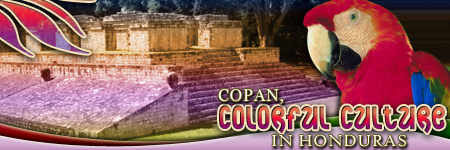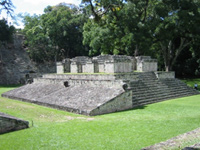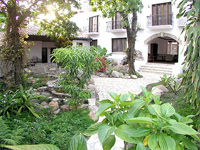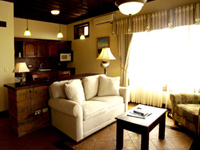|

Ancient culture meets New World savvy
in this popular tourist Mecca
by Jamie Gripich
The sound of marimba music rises off of the cobblestone streets and mixes with the aroma of spiced meats and fresh tortillas being grilled on street corners, and the voices of townspeople sharing the day in the town plaza. As locals would say it's a "typical" day in Copan, the heart of activity in north western Honduras.
 |
Mayan Ruins - Once Home to 30,000 |
Copan, with its narrow streets, brightly colored buildings, numerous cafes, restaurants, hotels and shops is a lively example of rural Honduran mixed with the bustle of a larger town. The signs of Copan’s past are everywhere. In this picturesque, artistic town, wood and stone carvings, corn-husk dolls and hand made leather trinkets are available everywhere. All are part of the part of the ancient color and fabric of Copan. In the time of the Maya, Copan was the Paris of the day – the artistic hub of the ancient world.
An ancient city, Copan was at its peak once home to nearly 30,000 Mayas at around 800 A.D. when the city was mysteriously abandoned. Most of the population was moved a few miles to the northeast to its current location. Current day Copan is far from 30,000 that once lived in the in the original city, now the ancient Maya ruins. About 5,000 people live in the current location, with another 20,000 scattered in the hillsides throughout the region.
The city is now surrounded by lush vegetation and jagged rolling hills. In fact, when archaeologists started visiting the area looking for the ancient Copan civilization, what they found initially were nothing more than large mounds of earth and foliage. The wild and abundant surroundings had literally reclaimed the landscape and covered the temples, housing and sculptures in dense underbrush. Yet over the last 100 years each scoop full of carefully removed earth has uncovered the once thriving culturally, politically, economically and religiously significant Mayan culture of Copan.
Some local families were instrumental in assisting archaeologists with food and lodging, and coincidently founded the now bustling tourism sector of Copan. In the early 1930’s, the Carnegie Institute in Washington, D.C., agreed to finance the excavation of the Acropolis area of the ruins, ushering in an era of increased visitation to the region. Many of those early visitors enjoyed the hospitality of the family of Doña Marina Villamil de Welchez who opened her home to them.
In the mid 40´s the family of Doña Marina decided to construct a modest, yet comfortable lodge for the growing number of visitors. The Hotel Marina Copan was named in honor of Doña Marina, a tribute to her pioneering efforts to attract visitors to this remote corner of Honduras. The hotel was built on the site of her family home in 1945.
 |
Hotel Marina Garden in Copan |
The Hotel Marina Copan is strategically located in the heart of downtown Copan, offering ready access to the cultural and natural wonders of the region. For the past 60 years, the hotel has expanded and changed to meet the needs of travelers from all over the world. Yet it still retains a magnificent sense of old world colonial architecture, with deep grained woods, colorful ceramic tile and bright plaster surrounding abundant natural courtyard gardens and a swimming pool that blends in naturally. Climb to the highest of the hotel’s balconies, and you’ll be rewarded with spectacular views of the town and the lush surrounding mountains which protect this mystical place.
From this town "hub" thousands of guests venture out to see the magnificent ruins, local museums and other natural agro tourism ventures which have grown up in the region.
The lush tropical surroundings are plentiful with banana trees, the local Cieba tree and Honduran Cedar among others. The shade provided by these tropical giants, combined with an elevation that provides cooling at night, are the perfect growing conditions for other crops like pineapple and coffee.
The Welchez family also operate a coffee farm or finca just a few miles out of Copan - Finca Santa Isabel, home to the Café Welchez coffee plantation. You can go by horseback or a quaint coffee wagon to the top of the plantation and take a walking tour down, viewing the complete, intricate ecosystem. Guides will introduce you to an abundance of plants, over 150 species of birds and other wild life that inhabit the system. Shade is natures best way to grow coffee, and through its production and processing, Welchez employees try to be as environmentally sensitive to the land base as possible. The result is a magnificently fragrant coffee that is both smooth and robust.
Throughout the ruins of Copan and recorded in the glyphs, stelaes and monuments is the Scarlet Macaw. The bird was revered by the ancient Maya and stood for a source of great power. The Scarlet Macaw is still revered by Hondurans, and can be found in its natural habitat among over 330 identified species of birds in the area. The Macaw Mountain Bird Park and Nature Reserve, an exciting new conservation project, lets visitors stroll along forest trails viewing brilliant multi-colored parrots, macaws and toucans, and other rare and endangered birds. Just a few minutes from Copan, the reserve covers an impressive tropical setting with hundreds of species of flowers blooming throughout the year.
 |
Hotel Marina Copan Guest Room |
Hotel Marina Copan offers other local tours as well: horseback riding to Hacienda San Lucas, where stone toads (Los Sapos) are believed to mark a birthing place for ancient Maya women; natural hot springs; a butterfly farm; and a zip-line tour, “flying” through the lush tropical canopy. MC Tours, a company offering safe and fully bilingual tours around Honduras, provides assist-ance with airport transfers to Copan and travel within Honduras.
Copan is a mix of ancient pride with new world savvy. After all, all children attending school are taught in both their native Spanish and English. It is a mystical place where that Hondurans revere, and modern place where people from all over the world come to meet. It is a humble, safe and secure place set against a prideful past. It is a society whose old world charm can still be experienced in a world that has become all together too similar.
Jamie Gripich is a professional freelance writer, editor and communications consultant living in Victoria, B.C. who has written on diverse subjects such as the civil war in the former Yugoslavia, to the peace and tranquility of B.C.'s West Coast resorts and retreats.
|